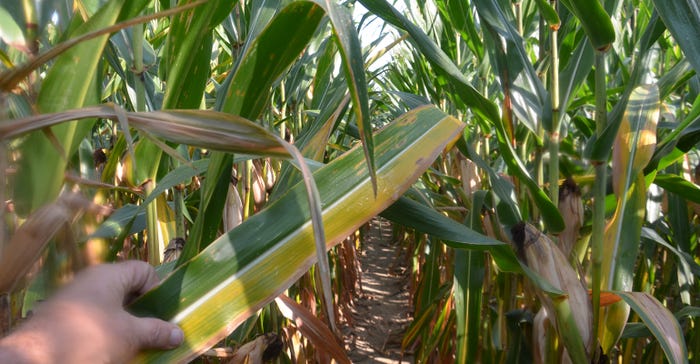
You walked cornfields before harvest to estimate yields. Stalks were still mostly green, but many leaves were showing signs of nutrient deficiencies. Is that important? Does it mean your soil fertility program isn’t supplying enough nutrients for good corn yields?
Dave Nanda saw these kinds of symptoms in the Corn Watch ’20 field in mid-September. “The first thing to do is not to panic,” Nanda says. “Instead, determine if kernels have already reached black layer. You can do that by pulling a few ears, picking off a few kernels and splitting them lengthwise. If there is a brown or black layer at the tip, the plant is physiologically mature. Moisture may still be 32% to 35% or so, but no more starch will move into the kernels.”
Related: Struggling corn plant: Weed or contributor?
Nanda, director of genetics for Seed Genetics Direct, sponsor of Corn Watch ’20, says that in September, he found both hybrids in the Corn Watch field were either at or very near black layer.
“We don’t worry as much if we see nutrient deficiency symptoms at that point as we would if they showed up earlier in the season,” he explains. “Plants have poured all the nutrients they can into kernels. Sometimes that means nutrients run low in other parts of the plant. You may see nitrogen, potassium or even sulfur deficiencies showing up, but it doesn’t necessarily mean yields were impacted.”
When these deficiencies show up earlier, it could be a different story. Nanda recalls that several years ago, he walked into a field in early August and noticed that lower leaves on almost every plant were showing distinctive signs of nitrogen deficiency. Grain fill was only at about the midpoint.
“In that case, there probably was yield loss,” he says. “The field still yielded over 200 bushels per acre, but there was no way to know what it might have made if the grower had supplied more nitrogen during the season.”

LEAF SHOWING DEFICIENCY: Dave Nanda notes that the light green to yellow color on part of this leaf could signify sulfur deficiency, but that isn’t confirmed.

Here are more observations about N and K deficiencies:
Nitrogen deficiency. According to the Purdue University Corn & Soybean Field Guide, yellowing starts at the leaf tip and moves up the midrib. Eventually — and especially later in the season — necrosis, or browning and dying of leaf tissue, will occur, usually first at the tip.
If you’re concerned that corn ran out of nitrogen too early, you can take stalk samples, even at harvest, and have them analyzed by a testing lab. You may want to consult a crop consultant for help taking samples. They typically cut out 8-inch sections of stalk about a foot above the ground and collect several stalk sections to make one sample.
Many crop consultants report that even though stalk sampling for N can be useful, there are no hard and fast guidelines as to how to interpret results.
Potassium deficiency. Symptoms usually show up first as yellowing and browning around leaf edges and may progress across the leaf later in the season. In 2019, Nanda found N and K deficiency symptoms on the same leaf on some plants. Again, it was just before harvest.
If you saw potassium deficiency earlier in the season, the best advice may be making sure that field is soil-sampled before next season.
About the Author(s)
You May Also Like




